
In a Huffington Post article at the beginning of 2014, noted strength coach and author Mark Rippetoe discussed the differences between training and exercise. Read the full article here, but in essence, Rippetoe says:
Training involves “directed physical stress,” and is “the process of going from where you are now to where you want to be later for the purpose of meeting a specific performance goal.”
“Exercise is physical activity performed for the effect it produces today—right now. Each workout is performed for the purpose of producing a stress that satisfies the immediate needs of the exerciser: burning some calories, getting hot, sweaty, and out of breath, pumping up the biceps, stretching—basically just punching the physical clock” (Practical Programming, 3rd Edition).
While some debate ensued regarding other specifics in the article, the real value of this discussion, in my opinion, is the standardization of semantics when discussing the effectiveness of a program. These definitions are useful because most people have no idea what the difference is between training and exercise—and as an affiliate owner or coach, you need to be able to explain to your members why Barry’s Bootcamp or SoulCycle are not actually training.
 The Spectrum Between Training and Exercise
The Spectrum Between Training and Exercise
I propose that we approach the conversation not by viewing exercise and training as an incompatible dichotomy. Rather, we should consider that a spectrum lies between them. Where any given program falls on that spectrum depends on, among other things, the intent of the program, the goals and culture of the population participating, and the amount of influence you have over that population on any given week (i.e., whether people are coming once or five times a week).
If our goal is to get good at CrossFit—which means increasing work capacity across broad time and modal domains—then there are certainly more and less effective ways to approach programming. No one could argue that someone blasting out 30-minute metcons day-in, day-out without ever lifting heavy or practicing skills is expressing CrossFit as effectively as someone with a balanced, thoughtful program. A good CrossFit affiliate should understand the differences between exercise and training, and bias practices that lead toward training such that we can see long-term quantifiable progress among our novice and advanced members.
Below is a list that further differentiates between the two ends of our spectrum. This list is valuable for easily differentiating where a program might fall on the continuum between exercise and training.
Characteristics of workouts that fall on the far end of the spectrum toward exercise include:
- No specific, long term performance goal(s)
- Non-quantifiable work output
- No standardization of range-of-motion in the exercises
- Inadequate intensity/stimulus to catalyze an adaptation
- Arbitrarily designed workouts which don’t fit into a larger plan
- No control or consideration of additional variables (recovery, nutrition, etc.)
Characteristics of workouts that fall on the far end of the spectrum toward training include:
- Pursues a specific goal or adaptation
- Quantifiable performance outputs
- Standardized range-of-motion in exercises being used
- Specifically-programmed intensities to develop or maintain physical capacities
- Each workout is part of a larger framework organized to achieve the specific goals of the program.
- Considers additional and complementary variables (recovery, nutrition, etc.)
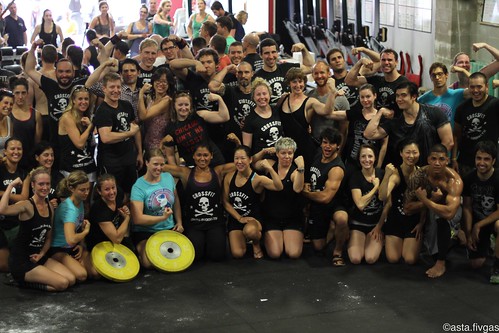 Considerations for Affiliate Programming
Considerations for Affiliate Programming
To have a conversation about training efficacy, you first need to define your goals. Of course, the primary goal of our program is to produce a broad, non-specialized competency of physical skills and capacities—i.e., well, CrossFit. CFSBK pursues this goal by programming a broad range of workouts and skills anchored in a consistent, progressive strength program. We also use leveled programming to accommodate for the different needs of novice and intermediate trainees at our gym.
You also need to know your population. CFSBK, like most affiliates, primarily works with a novice and intermediate non-competitive working population, in a group class format. Most people have the primary goal of feeling and looking better while getting better at CrossFit, and come to class anywhere from two to five times per week. Quantifiable, long-term improvements in general fitness are the ultimate goal for most of our trainees, rather than performance in a specific competitive event.
Below, we detail how CFSBK organizes our programming to accommodate for our population and goals, which involves minimizing interference from all different variables inherent in the programming. Each section summarizes our rationale, and includes some practical suggestions for implementation at your affiliate.
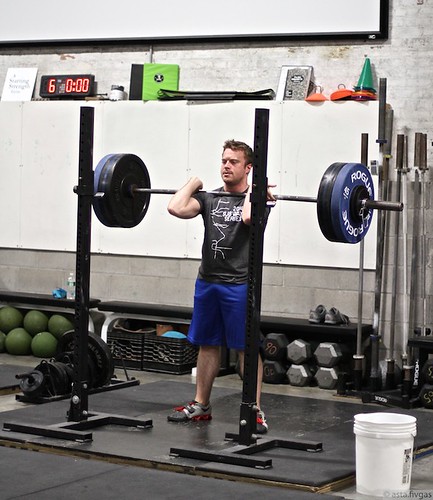 Strength Training
Strength Training
Especially for intermediate-level athletes, strength requires conscious planning in order to reap long-term progress. You can’t get really strong by accident. From our perspective, strength is one of the most deficient qualities of the population we work with and our programming reflects that by having a pre-set and progressive lifting schedule.
We’ve already written a couple articles on this topic. For a detailed explanation, read this article to see how we organize our lifts within our group classes, or read this and this article to learn about CFSBK’s dedicated strength programs.
- Create a consistent lifting schedule and program strength training in advance so that each exposure builds upon previous efforts.
- Creating this consistent schedule also allows your members to target their training more effectively, as they will know which days they need to show up to in order to advance particular lifts.
- Level the programming so that your intermediate and beginner athletes aren’t doing the same thing—someone training with you for four years versus four months will have exhausted linear progressions and will require more advanced programming.
- Program the rest of your assistance exercises, metcons, and skill work around these lifts, to minimize interference with them. For example, programming “Cindy” the day before a 1RM Back Squat would be counterproductive if you’d organized your training over the past month to achieve a new heavy single.
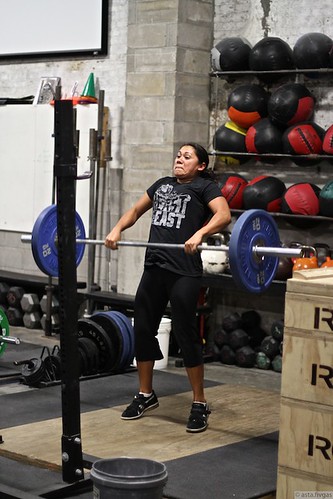 Olympic Lifting
Olympic Lifting
Relative to most exercises used at affiliates, Olympic lifting is a higher-skill activity that requires more practice to develop competency. Like we talked about with strength training, programming these lifts consistently allows for people to make more improvements than if they were programmed at random. Remember that programming for an individual is very different than trying to get a few hundred people on the same page. And again, a specific lifting schedule lets your members who want to get better at snatching know that, for example, every Monday for the next six weeks, snatches are programmed.
- Organize your lifting segments such that novices are getting led barbell drills before moving on to open lifting, while more advanced trainees can DIY their warm-ups and subsequently have more time to build up to heavier loads (read more about this here).
- Level the programming so beginners can work on sub-maximal technique complexes and advanced trainees can perform percentage or max effort lifts.
- Again, level the programming such that novice trainees are not prematurely exposed to high-rep Olympic lifting in metcons. Our “Fitness” programming often offers lower-skill exercises that allow newer members to push their conditioning hard without having to figure out a complex skill at the same time. Over time, we do want people to progress to the point where they can safely and consistently use Olympic lifts in timed formats; but we want to be prudent about the process by which they develop those motor skills.
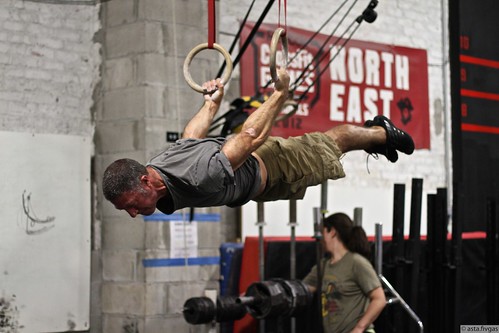 Calisthenics/Gymnastics
Calisthenics/Gymnastics
Development of calisthenics is often less straightforward than barbell training because body weight and anthropometrics play a much larger role in the progressions used and capacity of the individuals themselves to perform the movements. Given the range of gymnastics movements we commonly use in CrossFit, we can organize exercises into three tiers:
1st Tier (essential skills): air squats, strict pull-ups, chin-ups, push-ups, ring rows, lunges, dips, forward rolls, hollow rocks, l-sits and other isometric holds
2nd Tier (CrossFit Performance): strict and kipping muscle-ups, kipping pull-ups, ring dips/push-ups, handstands and handstand push-ups, pistols, rope climbing
3rd Tier (advanced CrossFit gymnastic skills): levers, planches, handstand walking, mini ring routines, flips, pirouettes, etc.
- In the spirit of the original CrossFit Warm-Up, our Standardized Warm-ups provide consistent class time for individuals to work on 1st tier body weight movements, which many novice trainees often lack proficiency in when starting up at the gym. As we mentioned in our previous article, warm-up time can also be valuable training time and an ideal place to practice and develop these movements.
- Level your programming so that less advanced athletes can work on 1st tier movements while more advanced athletes can perform 2nd tier movements. This avoids having to “over scale” movements like muscle-ups for folks who haven’t yet developed more foundational skills.
- Regularly program Not-for-Time assistance work for 2nd tier movements, so athletes can focus on improving these skills without the pressure of a clock. For example, one of CFSBK's recent assistance work segments involved 5 sets of 5 strict handstand push-ups. This allowed people on the verge of getting HSPUs to work on them and advanced athletes to increase their capacity with deficit versions.
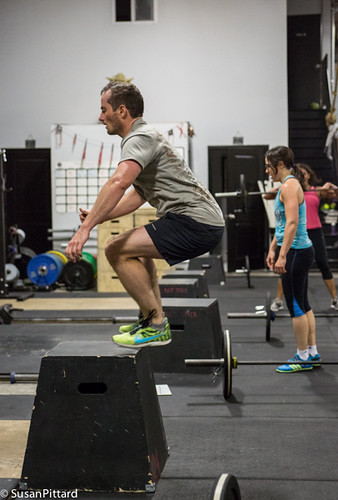
Conditioning
Part of being a well-rounded CrossFitter is having competency in a variety of time domains, so we need to program short, medium, and longer duration metcons in order to satisfy our performance objectives. Depending on the workout, exercises within metcons may intentionally or incidentally produce specific, favorable adaptations of increased strength or skill in a movement. While we’re all for that, we like to prioritize the intent of conditioning as development or maintenance of high levels of generalized work capacity.
- As mentioned earlier, minimize interference with primary lifting schedule.
- In order to manage the overall volume and stress of your programming, bias efforts ranging from the 5-15 minute range as well as interval-style work. It’s important to go long occasionally, but barn burner metcons are probably not where you want to live day-in, day-out when programming for most of the folks walking into your affiliate.
- Be responsive to your programming and population. Sometimes a metcon might create more soreness than originally intended, and a conscious programmer can modify upcoming efforts based on how they feel and on feedback from their population.
Conclusion
So, is CrossFit exercise or training? Well, to really answer that question, you'd have to evaluate specific goals and programming on a case-by-case, affiliate-by-affiliate basis. As we mentioned earlier, CrossFit—like strength training, Olympic lifting, or any other physical discipline—can be expressed more or less effectively, contingent on a variety of factors and the perspective of the observer.
For all the reasons stated above, we think CFSBK does a great job providing thoughtful, progressive programming. However, we will be the first to admit that some things we do in the gym bias what might be considered "exercise" more than others, which we're okay with. From our perspective, every rep or effort in the gym doesn’t need to be a well-calculated piece of a much larger puzzle. This is not because of the inherent limitations of programming for groups as opposed to individuals—rather, it is an intentional way that we shape our culture, and express enjoyment of movement as a large part of why we love working out. If your goal is general fitness, retention, and development of community (which is CFSBK’s goal), then I suggest being intentional with your programming, while also having some fun with it and not sweating all the details too much. Consider what you do and why you do it, then continue to refine your approach to suit your needs.
As CrossFit grows, it’s important for professional coaches and gyms to take the lead on what the standards are regarding making CrossFit more training than exercise—and communicating with each other about what practices seem to be working best at our facilities. I have no doubt that there are plenty of affiliates out there doing things differently than we are and also achieving long-term progress with their members. Please continue the conversion and help us all develop as a community and training program.